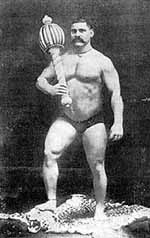Clubbells and Indian Clubs: Legit Rehab Tools or Passing Fitness Fads?
 |
| For thousands of years Indian Club training has made guys in their underpants way stronger than you are. |
If this is the first time you’ve heard about Indian Clubs or Clubbells, you’re a little behind the curve. They’ve been used as training tools for fighters from all around the world from Russia to Iran for thousands of years. You could argue the case that the club has been around as a weapon and training tool for about as long as the opposable thumb.
Pehlwani wrestlers popularized club training in India in the early 1900’s. To this date The Great Gama is the only wrestler in history who has remained undefeated his whole life which was substantial, as his career had spanned more than 50 years.
 |
||||||||
| The Great Gama |
Club training clearly worked for Gama. If you are looking to dominate the Pehlwani Wrestling circuit you would be a fool to leave clubs out of your routine. The more relevant question is whether or not this training has a universal application. Are Clubbells merely a fun way to mix up the routine and run the house in obscure Indian Wrestling circuits, or are they useful tools for adding stability to injured shoulders and strength to competitive olympic lifters and kettlebell competitors? I just began working with clubs recently. The following are my initial observations:
PROS
- I’m Not Good At Clubbelling. This is good. Beginers make progress fast, progress that may transfer over to stability and strength in other areas.
- Accuracy- You must be precise when performing a clubbell move. A wrist angle slightly off is amplified by the length of the club bringing an otherwise acceptable snatch crashing down onto your shoulder.
- Grip- In many moves, you are throwing the club away from the body and stopping that momentum with the strength of your grip. This move is called The Mill. When performed with the proper intensity, it replaces an athlete’s hands with what feel like monkey claws.
- Variety- Due to the specific angles that can be created at the wrist with this long lever arm, there are infinite applications and movements to train.
 |
| “The night time is the right time. . . “ |
CONS
- Perhaps due to their perceived Indian roots, many feel compelled to attach a psuedo-spirituality to the teaching and practice of clubbelling. See photo.
Plan:
- Master a few basic clubbell moves that address my shoulder weaknesses (mills, casts etc.)
- Add these moves as a supplement to my typical crossfit training
- As an experiment, compete in a USAW olympic lifting competition and an IKFF Kettlebell Competition in September and see if the clubs lend some universal strength and stability
 |
|||||||||
| If it works for this guy. . . |
Latest posts by Skylar Pond (see all)
- Admin Fee - January 28, 2024
- BJJ Blackbelt loving his first Ring Dinger® treatment - August 27, 2023
- Sleep Optimization Protocol - February 7, 2023
